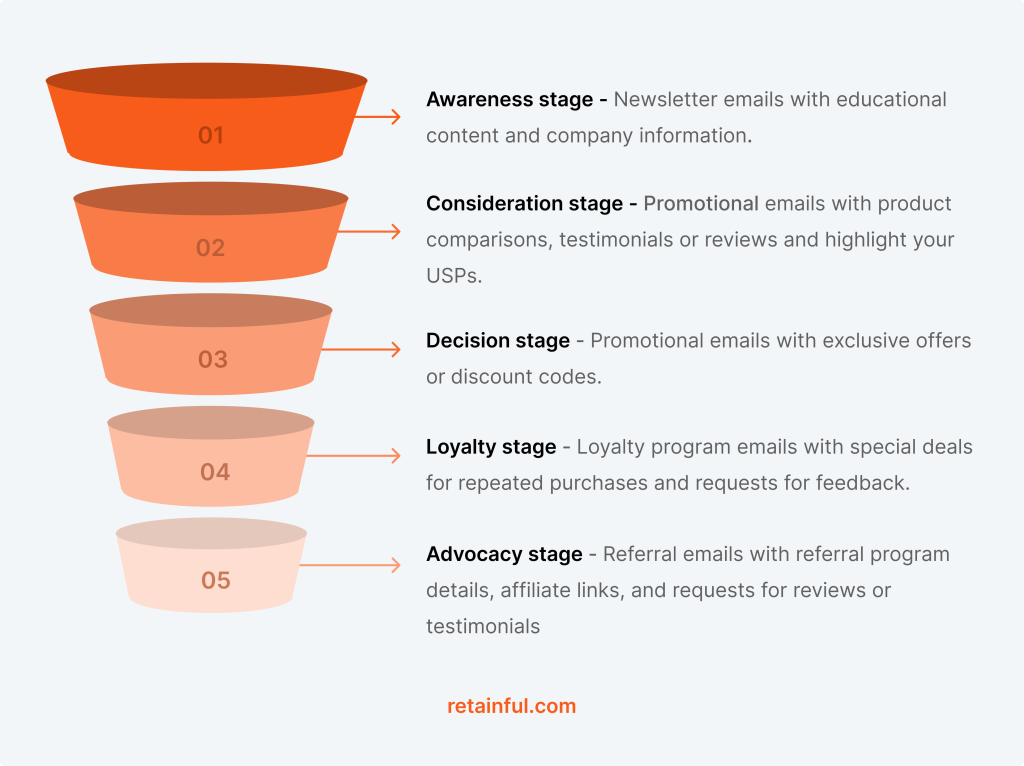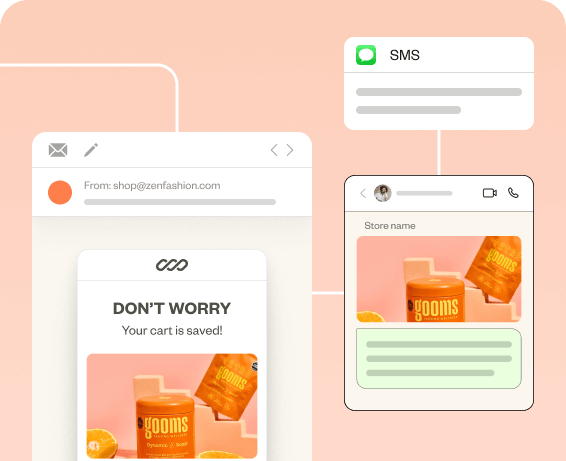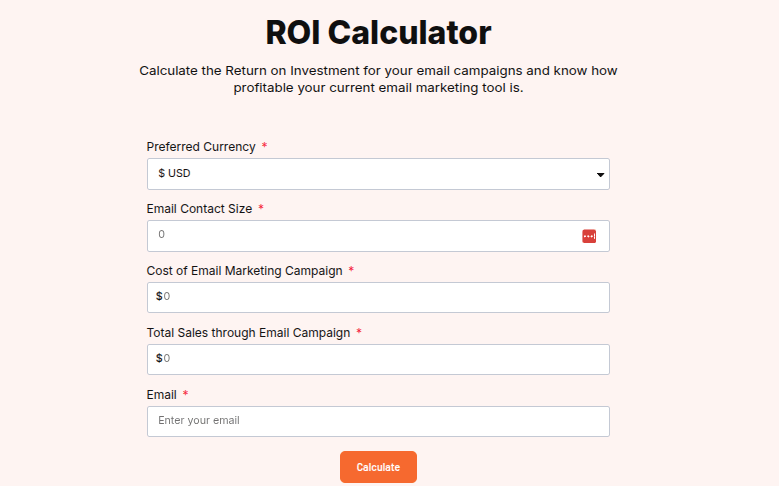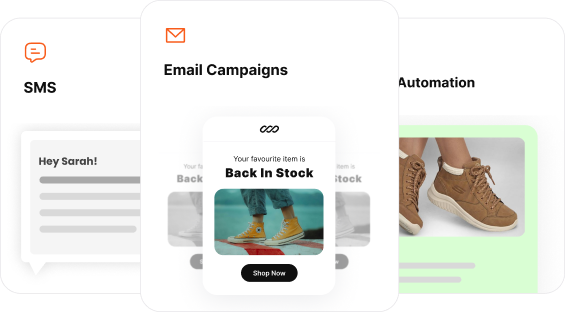Having a solid customer acquisition strategy is a must for an ecommerce business for continuous and sustainable growth.
Without a clear acquisition strategy in place, businesses spend a lot on CAC (Customer Acquisition Cost) for a minimal ROI. It also results in poor lead quality, low conversion rates, and unpredictable dips in your business growth.
To overcome these challenges, you’ll need a customer acquisition strategy that suits both your business and your customers.
That’s why in this blog, we have discussed
- What a customer acquisition strategy is
- 10 best customer acquisition strategies
- How to create your own strategy to acquire new customers
Acquire qualified leads effortlessly with Retainful’s targeted email campaigns and advanced automations.
Key Takeaway
- Client acquisition strategies for B2B and B2C businesses
- How to calculate your customer acquisition cost
- Best customer acquisition channels
What is Customer Acquisition Strategy?
A customer acquisition strategy is the plan businesses have to bring in new customers within the allotted CAC. A good customer acquisition strategy will attract potential customers, nurture leads, and convert them into paying customers.
What is CAC (customer acquisition cost): CAC is a metric that refers to the amount and resources spent by businesses to gain a new customer.
CAC = Marketing spend / Customer Acquired
10 Best Customer Acquisition Strategies
Having the right customer acquisition strategy in place helps you consistently grow your customer base. In addition to that, it ensures you’re investing in channels that convert.
Here is a list of the 10 best customer acquisition strategies:
- Email Marketing
- Content Marketing
- Search Engine Optimization (SEO)
- Social Media Marketing
- Affiliate Marketing
- Collaborations and Partnerships
- PPC (Pay Per Click)
- Marketplaces
- Referral Programs
- SMS Marketing
1. Email Marketing
Email marketing is an ideal customer acquisition strategy for B2C and B2B businesses. It’s also highly effective for DTC brands, SaaS companies, and service providers, as it can deliver personalized emails.
Email marketing as a B2C customer acquisition strategy:
- Welcome Email Series: It is your first attempt at turning a visitor into a customer. Moreover, offering a discount with the welcome message can increase the likelihood of a first purchase.
- Abandoned Cart Recovery: Cart recovery emails target visitors who showed buying intent but didn’t complete the purchase. It helps you to save almost lost customers.
- Referral Campaigns: Encourage existing customers to refer friends by offering discounts or reward points. It is an effective way to grow your customer base organically.
Email marketing as a B2B customer acquisition strategy:
- Email Newsletters: Send regular newsletters with industry trends, product updates, and customer stories. It builds trust. Moreover, it lets you establish yourself as an expert in your niche.
- Lead Nurturing Campaigns: Offer free trials, downloadable guides. tips or time-sensitive discounts. Consequently, it helps you to grow your subscriber list with high-quality leads.
You can use drip email campaigns for both B2B and B2C businesses. Set up a series of automated emails sent out at predefined times or triggered by specific actions taken by recipients.
Send automated email drip campaigns that are triggered based on customer behavior and well-timed intervals with Retainful.
2. Content Marketing
Content marketing is the process of creating and publishing content for better visibility and engagement.
However, for B2B businesses, content marketing is essential to educate leads and build authority. On the other hand, B2C businesses can use content marketing to drive traffic and increase product visibility.
Content marketing as a B2C customer acquisition strategy
- Product-Focused Blog Posts: Write informative articles around your products, such as how-to guides, comparison posts, or seasonal shopping tips. These help potential customers find your brand through search engines.
- Video Content & Tutorials: Create short videos or reels showcasing product features, unboxing, or customer use cases. Include User Generated Content (UGC) in your videos. As a result, you can increase brand credibility and acquire customers in the Consideration stage.
- Social Media Content: Repurpose blog and video content into engaging social posts that drive traffic to your site and encourage sign-ups or purchases.
Content marketing as a B2C customer acquisition strategy
- Thought Leadership Articles: Publish in-depth blog posts, whitepapers, or opinion pieces on industry trends, challenges, and solutions. Then, use them to attract decision-makers looking for expert insights.
- Case Studies and Testimonials: Showcase real-world success stories to demonstrate your product’s effectiveness and build trust with potential clients.
- Landing Pages: Optimize content-rich landing pages for high-intent keywords to capture leads searching for solutions to specific problems.
Related Reading: Ecommerce Email Marketing: Strategies + Software
3. Search Engine Optimization (SEO)
Unlike paid ads, SEO is a sustainable, long-term customer acquisition strategy. By targeting relevant keywords and creating valuable content, SEO drives qualified visitors to your site.
Both B2B and B2C businesses can use SEO strategies in their marketing for organic customer growth.
Key SEO tactics for customer acquisition:
- Find the keywords (search terms) your potential customers use to find products or services like yours.
- Create high-quality content (eg, blogs, faq, guides) that addresses the pain points of your target audience.
- Optimize your landing page, article pages with the relevant keywords and readable content.
- Ensure your websites load faster and have proper site architecture for easy crawling.
- Make sure your website is mobile-friendly.
- Create backlinks from reputable websites to increase the site’s authority. Consequently, it will help you to rank better in search engines.
4. Social Media Marketing
Everyone checks out social media platforms like Facebook, Instagram, LinkedIn, X, and Pinterest every single day.
So, it’s natural that businesses want a strong social presence for branding, visibility, and engagement.
How to use social media for customer acquisition:
- Organic Content Strategy: Share valuable posts, behind-the-scenes content, product demos, and even customer stories to attract and engage followers.
- Paid Social Ads: Run targeted ad campaigns with special offers, product launches, or lead magnets. As a result you can generate more quality leads and drive conversions.
- Influencer Marketing: Partner with niche influencers to tap into their audience and drive high-intent traffic. It will let you tap into exclusive market segments. Furthermore, in such market segments the competition will be lower.
- Contests & Giveaways: Launch social media contests to increase reach and encourage shares, follows, and email sign-ups.
Why social media is a good customer acquisition strategy:
- High Reach & Visibility: Platforms like Instagram and TikTok help B2C brands reach millions of users with engaging visual content.
- Targeted Ads: Use advanced targeting to reach specific demographics, interests, or behaviors.
- Trust & Social Proof: Customer reviews, UGC, and influencer collaborations build credibility and influence buying decisions.
- Lead Generation: Platforms like Facebook and LinkedIn offer built-in lead generation forms to capture email addresses directly from ads.
- Community Building: Engaging with followers consistently in social media will let you acquire a loyal customer base.
Related Reading: Retention Marketing: Strategies + Examples (2025)
5. Affiliate Marketing
Affiliate marketing is a cost-effective and scalable customer acquisition strategy. It lets you leverage the influence of niche marketers who can drive high-intent traffic and conversions.
You can partner with affiliates such as bloggers, influencers, and content creators to promote your business.
How to do affiliate marketing to acquire new customers:
- Create an Affiliate Program: Use tools like Afflr on platforms like Shopify to set up and manage your program.
- Offer Competitive Commissions: Attract top affiliates by providing appealing commission structures and performance incentives.
- Provide Marketing Assets: Equip your affiliates with ready-to-use banners, email copy, and product descriptions to ensure consistent messaging.
- Track and Optimize Performance: Monitor affiliate channels and optimize campaigns based on top-performing partners.
Why affiliate marketing is a good customer acquisition strategy:
- Performance-Based Model: You only pay when a customer is acquired, making it a low-risk, high-ROI strategy.
- Wider Reach: Affiliates can introduce your brand to audiences you might not reach through paid ads or organic content alone.
- Scalability: You can grow your customer base by continuously onboarding new affiliates without increasing your internal marketing workload.
6. Collaborations and Partnerships
Collaborations and partnerships involve two or more brands working together to reach new audiences, generate leads, and drive mutual growth.
How Collaborations Drive Customer Acquisition:
- Access to New Audiences: Partnerships help you tap into a pre-qualified audience that already trusts your partner’s brand.
- Shared Marketing Costs: Both brands share resources and marketing efforts, making it cost-effective for both sides.
- Cross-Promotion Opportunities: You can co-host webinars, co-create content, or run joint giveaways that generate leads for both parties.
Effective Types of Partnerships for Customer Acquisition:
- Co-Marketing Campaigns: Collaborate on blog posts, podcasts, or videos that promote both brands and capture leads through shared landing pages.
- Product Bundles or Joint Offers: Combine products or services into a bundled deal to provide more value and attract new buyers.
- Referral Partnerships: Build relationships with businesses that serve a similar audience and reward them for each customer they refer to you.
- Influencer or Creator Collaborations: Work with influencers in your niche to co-create content, host live events, or promote limited-time offers.
- Event Sponsorships & Webinars: Partner with non-competing brands to sponsor events or host educational webinars, expanding your visibility and authority.
7. PPC (Pay per Click) Advertising
Pay-Per-Click (PPC) advertising is one of the most direct and measurable customer acquisition strategies. It allows businesses to place ads on platforms like Google Ads, Facebook Ads, and Bing.
Businesses only pay when someone clicks on the ad. This makes it ideal for businesses looking to drive targeted traffic and generate leads.
How PPC Helps with Customer Acquisition
- Immediate Visibility: Your ads appear at the top of search results or in front of your ideal audience instantly, giving you immediate reach.
- Conversion Tracking: With tools like Google Analytics and Facebook Pixel, you can track every click, conversion, and ROI precisely.
- Highly Targeted Reach: PPC allows granular targeting by demographics, location, device, interests, search intent, and even behaviors.
Popular PPC channels for customer acquisition:
- Google Search Ads: Capture high-intent users actively searching for your product or service.
- Google Shopping Ads: Ideal for eCommerce stores.
- Facebook & Instagram Ads: Build awareness and convert users with interest-based targeting.
- LinkedIn Ads: Best for B2B customer acquisition.
- Retargeting Ads: Re-engage users who visited your site but didn’t convert.
8. Marketplace
Selling on online marketplaces like Amazon, Etsy, eBay, or Flipkart is a highly effective customer acquisition strategy. These platforms already have massive, high-intent user bases.
It gives your products instant exposure to millions of potential buyers actively searching for what you offer.
How marketplaces help with customer acquisition:
- Built-In Traffic: You gain access to a ready-made audience with strong purchase intent. It is ideal for acquiring customers quickly.
- Search Visibility: Marketplaces have their own search engines. With proper SEO (product titles, descriptions, keywords), you can appear in top results.
- Lower Entry Barrier: You don’t need a fully developed website. Marketplaces allow you to start selling and acquiring customers with minimal setup.
- Trust & Credibility: Buyers trust platforms like Amazon and Etsy, which can increase conversion rates for newer or lesser-known brands.
- Product Discovery: Marketplaces surface your listings through categories, search filters, and recommendation engines, helping you reach customers who might never find your brand otherwise.
9. Referral Programs
Referral program is a trust-driven customer acquisition strategy. It involves encouraging your existing customers to refer friends and family to your brand for discounts or reward points.
A well-structured referral program can create a loop where new customers become referrers, fueling continuous growth. Investing in referral programs leads to natural word-of-mouth growth.
How to use referral programs for customer acquisition:
- Incentivize both the referrer and the new customer with discount emails, credits, or freebies.
- Provide personalized referral links, social sharing buttons, and a simple sign-up form.
- Promote your referral program in your marketing channels, for example, in post-purchase emails and social media shoutouts.
- Track key marketing metrics like referral conversion rate, average order value of referred customers, and CAC to refine your program.
10. SMS Marketing
SMS marketing is a high-conversion, D2C customer acquisition strategy. It has one of the highest open rates and engagement rates.
Moreover, SMS marketing is a mobile-first approach. Since most users shop or browse on mobile, SMS aligns perfectly with this customer behavior.
How to use SMS for customer acquisition
- Welcome Offers: Send an instant discount code or gift to new subscribers who opt in via SMS.
- Abandoned Cart Reminders: Recover lost sales by sending a reminder with a limited-time offer or free shipping.
- Flash Sales & Time-Limited Deals: Create urgency by promoting exclusive offers through SMS blasts.
- Referral Program Promotions: Use SMS to remind existing customers to refer friends and reward both parties.
How to Develop a Customer Acquisition Strategy?
A well-defined strategy ensures you’re bringing in right king of customers into your business. It lets you target the right audience, using the right channels.
Here are the steps to create your customer acquisition strategy:
- Create your ICP (Ideal Customer Profile)
- Segment Your Leads Based on Funnel Stage
- Choose Your Marketing Channel
- Create Personalized Campaigns
- Measure ROI and CAC to Optimize
1. Create Your ICP (Ideal Customer Profile)
Start by identifying who you want to attract. This is the foundation of your customer acquisition strategy. Your ICP is a detailed description of the perfect customer for your product or service.
It helps you focus your acquisition efforts on conversion and loyal customers who have high CLV. You can create multiple ICPs to serve different marketing segments effectively.
You can develop ICPs based on:
- Demographics: Age, gender, income level, job title, company size.
- Geographics: Location, language, time zone.
- Behavioral traits: Purchase history, engagement level, decision-making process
- Challenges: What problems do they face that your product can solve?
- Analyze your best existing customers to identify the common traits.
Having a clear ICP will let you clear KPIs and goals of your customer acquisition strategy.
2. Segment Your Leads
Segmenting your audience will let you identify your goals, and create targeted customer acquisition strategies. Lead segmentation allows you to align your messaging to their stage in the marketing funnel.
Segmenting by funnel stage ensures each lead receives relevant content and offers at the right time.

Besides the marketing funnel, you can use the RFM method to retarget different segments of your customers more effectively.
- Recency: How recently have they purchased?
- Frequency: Number of times they have purchased in a given time frame.
- Monetary: The AOV (Average order value) of their purchase
For high-value customers, send referral links to leverage word-of-mouth marketing. Meanwhile, for inactive and churn customers, send reengagement emails with discounts to retarget them.

3. Choose Your Marketing Channel
Not all channels work equally for all audiences. Based on your ICP and budget, choose the channels that are most likely to reach and engage your target customers.
Your channels should reflect where your ICP spends time and how they prefer to consume information.
Don’t overwhelm yourself with too many marketing channels at once. Start with 2-3, find your best performers. Once you have the best channels, gradually expand to an omnichannel approach.
Popular acquisition channels include:
- Paid Ads: Great for targeting and scaling.
- Email Marketing: Effective for nurturing and retention.
- Social Media: Good for awareness and engagement.
- Partnerships/Referrals: Cost-effective and high-converting.
Based on the channels you choose, and your budget you can select your marketing tool. For instance, to do email marketing you can choose a tool like Retainful. It offers advanced email automation and segmentation capabilities.
4. Create Personalized Campaigns
Use what you know about your ICP and lead segments to create personalized campaigns in different marketing channels. This way, you can address each segment’s pain points and identify which channel works the best.
You can use information like the source of signup, location, and behavior to create personalized and targeted campaigns.
For example, you can personalize emails using
- Shortcodes for including customer details, purchase information, and recommendations.
- Exclusive and dynamic one-time use coupon codes.
- Dynamic content block for images and GIFs.
5. Measure Your ROI and CAC to Optimize
No strategy is perfect at launch. Continually test and improve.
- Test with different email subject lines, ad creatives, landing pages, etc.
- Analyze acquisition cost vs. CLV(Customer lifetime value).
- Double down on high-performing channels and cut underperforming ones.
Save huge on acquisition costs with Retainful’s smart signups and automated campaigns.
Wrap up
A successful customer acquisition strategy is about gaining the right customers at the right cost, through the right channels.
To find your winning strategy, the first step is to have a thorough understanding of your customers. Identify how different segments of customers consume information to build your customer acquisition strategy
From email marketing to SEO and partnerships, each strategy plays a unique role in helping you convert high-quality leads. Experiment with different customer acquisition strategies as you tap into different customer segments.
Also Read
- 10 Best Email Marketing Software Comparison and Review
- The 11 Best Email List Building Tools To Increase Conversions
- 19 Effective Email Marketing Strategies for 2025
Frequently Asked Questions
It ensures efficient use of marketing budgets, delivers measurable results, and ensures sustainable, long-term growth.
Typical channels include SEO, social media, email, PPC, events, partnerships, and traditional media.
Key metrics are Customer Acquisition Cost (CAC), conversion rate, Customer Lifetime Value (CLV), and ROI.
CAC = (Total marketing & sales cost) ÷ (Number of new customers acquired).
CLV estimates the total profit a customer generates over their relationship; companies aim for LTV: CAC ratios of at least 3:1.
By using analytics, iterating based on performance, and focusing on high-return channels.
Acquisition involves gaining new customers, while retention focuses on keeping and growing existing relationships; both are interdependent.



